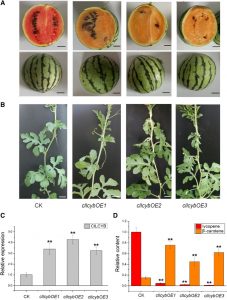How Cultivated Watermelon Derived its Red Flesh
 Modern cultivated watermelons (Citrullus lanatus) are sweet tasting and tender, with intensely colored flesh that ranges in hue from yellow to deep red. These colors are produced by the accumulation of various carotenoids in the flesh cells. Red-fleshed watermelons that accumulate lycopene in their flesh cells have been selected and domesticated from pale-fleshed ancestors. Red-fleshed watermelons contain even more lycopene per unit of fresh weight than tomato (Solanum lycopersicum) and this lycopene is easier for the body to absorb. Thus, one of the current objectives in watermelon fruit quality improvement is increasing the carotenoid content, although the molecular basis of lycopene production in watermelon remains poorly understood. By means of map-based cloning and transgenic analysis, Zhang et al. (10.1104/pp.19.01409) have identified a lycopene b-cyclase (ClLCYB) gene that controls the flesh color of watermelon. Down-regulation of ClLCYB caused the flesh color to change from pale yellow to red, and ClLCYB overexpression in the red-fleshed line caused the flesh color to change to orange. An analysis of over 200 watermelon accessions with different flesh colors revealed that two missense mutations between three haplotypes (ClLCYBred, ClLCYBwhite, and ClLCYByellow) were selected and largely fixed in domesticated watermelon. The plastid proteins derived from these three ClLCYB haplotypes catalyze the conversion of lycopene to b-carotene. Another important finding is that ClLCYB protein abundance, instead of ClLCYB transcript level, is negatively correlated with lycopene accumulation. Thus, natural missense mutations in ClLCYB apparently influence ClLCYB protein abundance and contribute to the red flesh color in domesticated watermelon.
Modern cultivated watermelons (Citrullus lanatus) are sweet tasting and tender, with intensely colored flesh that ranges in hue from yellow to deep red. These colors are produced by the accumulation of various carotenoids in the flesh cells. Red-fleshed watermelons that accumulate lycopene in their flesh cells have been selected and domesticated from pale-fleshed ancestors. Red-fleshed watermelons contain even more lycopene per unit of fresh weight than tomato (Solanum lycopersicum) and this lycopene is easier for the body to absorb. Thus, one of the current objectives in watermelon fruit quality improvement is increasing the carotenoid content, although the molecular basis of lycopene production in watermelon remains poorly understood. By means of map-based cloning and transgenic analysis, Zhang et al. (10.1104/pp.19.01409) have identified a lycopene b-cyclase (ClLCYB) gene that controls the flesh color of watermelon. Down-regulation of ClLCYB caused the flesh color to change from pale yellow to red, and ClLCYB overexpression in the red-fleshed line caused the flesh color to change to orange. An analysis of over 200 watermelon accessions with different flesh colors revealed that two missense mutations between three haplotypes (ClLCYBred, ClLCYBwhite, and ClLCYByellow) were selected and largely fixed in domesticated watermelon. The plastid proteins derived from these three ClLCYB haplotypes catalyze the conversion of lycopene to b-carotene. Another important finding is that ClLCYB protein abundance, instead of ClLCYB transcript level, is negatively correlated with lycopene accumulation. Thus, natural missense mutations in ClLCYB apparently influence ClLCYB protein abundance and contribute to the red flesh color in domesticated watermelon.



